
How To Combat Environmental Change In Your Garden
With the possibility of changing climates comes the inevitable pressure for us to improve our local and garden environment. I am not completely sold on climate change, it seems to me to be another money spinner for governments and businesses. But as gardeners we can look at various ways of improving our gardens for wildlife, simply by changing our gardening habits.
Our choice of plants and landscaping options can play a vital role in the improvement of our environment and its ultimate survival.
We, as gardeners, have a responsibility to try to do as much as we possibly can to benefit all wildlife by developing green spaces full of diversity.

How To Combat Environmental Change In Your Garden
One thing we can do is save rain water and waste water. Using water to keep the lawn green during a drought is no longer an acceptable practice.
Conserve rain water by installing water butts, not only to collect rain from the main house roof, but also rainwater off outbuildings and greenhouses.
We can help reduce pollution and flooding.
Using cordless power tools can also help to reduce carbon emissions.Ryobi OLM1833H ONE+ Lawn Mower, 18 V Review
Plant as much greenery as possible. Hedges, shrubs and trees are much more preferable to fences or walls. Hedges collect pollution, making the air cleaner.
Trees dispel pollution and can also alleviate flash flooding.

Trees also provide much needed shade during a heatwave.
Create a living roof on any outdoor buildings such as a shed, garage, bike store, refuse bin stores and outhouses. My article, How To Create A Green Roof On Your Garden Shed shows you how in an easy to follow step by step guide. Green roofs increase the diversity of insects, pollinators, birds and small animals. They also help to reduce air pollution.
Improve the soil by adding more organic matter and homemade compost. This creates a soil that will store more carbon and aids in water retention and further more, it can make gardens more resilient in either flood or drought conditions.
Make everything in your garden permeable. We as a nation, in pretty much every town, have been responsible for causing flooding problems by paving front gardens.
There are carpark solutions that are permeable so we can have the best of both worlds: parking and a front garden.Plants For Spring Colour
Also trees and shrubs around the perimeter of a car parking area would help the environment.
Planting more garden greenery won’t stop climate change, but it could make our communities more resilient when faced with extreme weather. Gardeners can help to combat heat, flooding, drought and changing weather patterns.
Extreme weather conditions, heavy rain, drought, storms will be the norm in future years. We have a duty to do what we can now in order to counteract the damage that these weather changes will undoubtably cause.
Regional Gardening
Recent research looks at lawn-mowing as an indicator of climate change. It shows that in many southern areas of England it is now considered normal to continue mowing lawns for longer into the winter season.
Particularly in warmer, wet areas such as Devon and Cornwall this is the case.
I certainly keep my lawn cut well into December.Ryobi OLM1833H ONE+ Lawn Mower, 18 V Review
The town of Northampton is seen to mark a rough boundary between the two most distinct climate zones in the UK
An RHS study shows how gardeners to the north of Northampton regularly mow their lawns more often in early spring and late autumn, something towns south of Northampton have been doing for many years.
For the SouthWest, it is suggested that we will experience a higher average temperature, approximately 3C higher than it is currently with heavy winter rain and more storms.
It is predicted that many lawns there will become woodland or shrub areas as mowing would have to be a year-round job and there would be no point to having turf that cannot be mowed when it is water-logged.
Larger trees which are more vulnerable to being blown down in strong winds will be replaced with smaller varieties. Slopes will have to be cut into and terraced to help stop soil erosion.
In North England there is a predicted 2C rise with longer, heavier spells of winter rain, more extremes and more storms. Plants will have to cope with sudden condition changes.
Pests and Diseases
One of the issues we see is an influx of new pest and diseases or the ones we already contend with becoming more and more prevalent.
After the long, hot summer of 2018, in some areas there was an increase in lily beetles and lace bugs, both of which can cause serious damage to plants.
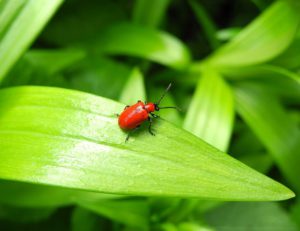
Moles will survive milder winters.
Some of our nations trees are under threat because of the increase in diseases and pests that are thriving in our milder, wetter winters. Or in our hotter summers.
In the warmer, wet counties of Cornwall and Devon we experienced the spread of Fuchsia gall mite. This harmful bug arrived in the UK in 2007 and is rapidly spreading.
There are more fungal problems because of less severe frosts.
Winter is no longer cold enough to kill off harmful bugs, viruses, insect eggs or spores.
Rain Gardens
A rain garden or stormwater garden is designed with the purpose of temporarily holding rain water collected from runoffs that come from building roofs, driveways and patios.
It is a shallow depression formed in a part of the garden that naturally slopes. It is planted around the perimeter with a natural planting scheme using shrubs and perennials.
Rain gardens effectively remove up to 90% of pollutants and chemicals as well as up to 80% of sediments from the rainwater runoff.
In comparison to a conventional grass lawn, rain gardens will soak up to 30% more water.
A rain garden only holds and soaks away water in extreme, heavy rain conditions; it is not a water garden or a pond. In actual fact a rain garden is mostly dry.
It typically holds water only during and following rainfall.
As rain gardens will drain within 12-48 hours, they prevent the breeding of harmful bugs and pests
Rain water runs off impermeable surfaces, such as roofs or driveways. In doing so it collects pollutants such as dirt, fertiliser, chemicals and bacteria along the way.
The polluted water then enters storm drains flowing directly to nearby streams and ponds.
By making a rain garden we can collect rainwater runoff which allows the water to be filtered and purified by vegetation. In turn the water percolates into the soil taking a lot less pollutants with it.
In the design of a rain garden, typically six to twelve inches of soil is removed, compost and sand is then added to increase water infiltration.
It is advisable to do a soil test as this will indicate the type of soil you have and the amount of sand and compost that is required.
Rain gardens should be constructed on the downside slope from your property and collect rainwater runoff from the lawns, roof, patios and driveway. Once water collects in the rain garden, infiltration may take up to 48 hours after heavy rainfall. As rain gardens incorporate native vegetation no fertilizer is needed and maintenance is minimal.
Runoff rain water can be collected by using water butts, this water is then redirected to your rain garden.How to Make a Rain Garden
Depending on the style of garden you wish to design, water can be piped in a natural looking way or maybe by a series of rills would give a more modern, contemporary feel.
Which Plants Are Best For A Rain Garden?
A mixed selection of native wildflowers, rushes, sedges, ferns, small shrubs and/or trees will soak up excess water flowing into the rain garden. The different soil layers filter out pollutants, chemicals and bacteria before the water enters the groundwater system.
Deep plant roots also create additional channels for stormwater to filter into the ground.
By having a variety of plants and vegetation around the rainwater garden gives a good root system which will enhance infiltration and help to maintain soil permeability.Perennial Plants. First Year Flowering
Plant roots also provide moisture redistribution.
Also, rain garden plants return water vapour to the atmosphere.

Plants for Rain Gardens
- Cardinal lobelia. Hardy plants that thrive in sun or part shade, in heavy clay, damp or boggy soils.
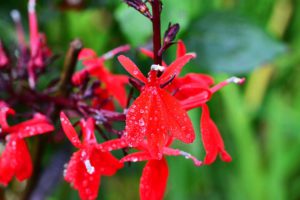
Lobelia - Astilbe. These perennial plants have gorgeous plumes of flowers above soft fern-like foliage. They prefer shade and damp soils.

Astilbeu - Hostas. Another shade loving and moisture loving plant. They are favoured for their variety in leaf colour and size, easy to grow hardy perennials.

Hosta - Sedges and Rushes. Although slightly different from each other, both sedges and rushes prefer wet soils and can also tolerate deep shade. They add texture and movement to gardens.
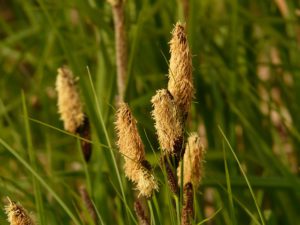
Sedges - Siberian Iris. Spring flowering Iris that will grow in wet or poor draining areas. They are perfectly happy in low standing water.

Iris
If like me, you have a generally wet garden or areas of the garden that are more extremely wet than others, then read on for my suggested plant list, some of which are the same as for a rain garden plus some others that I find perfect for growing in wet soils or clay soils
Plants for Wet Gardens.
- Astilbe.
- Hostas.
- Astrantia. Clump forming herbaceous perennials with white, pale pink or deep pink umbels.

Astrantia - Rudbeckia. Hardy perennial plant with bright yellow daisy flowers, flowering well into late Autumn.

Rudbeckia - Persicaria. These are wonderful ground cover plants with deep green foliage and pink, white or red flowers.
- Cornus Alba. Grown mainly for their deep red stems, Cornus afford all year round interest and look good in informal groups with other winter shrubs such as Hamamelis.

Cornus Alba - Liquid Amber. A deciduous tree that grows happily in moist but well drained soil, clay, sand or loam. They give all year round interest particularly in autumn when the foliage is deep red.
- Hydrangea paniculata. A deciduous shrub with bushy, lush green growth, flowers from late summer into autumn. Prefers moist, well drained soil.
- Cephalanthus occidentalis. (Button bush) This fragrant shrub prefers full sun and well drained sandy loam.
- .

Button Bush
My plant suggestions below are for gardens that are naturally more prone to be dry. They are also ideal for a low maintenance garden if one has little time to water plants. Easy Low Maintenance Garden Ideas In terms of the environment, these plants are ideal in drought conditions when we need to look to conserving water.
Plants for Dry Gardens.
- Bearded Iris. They thrive in full sun, flowering throughout summer. Rhizomes need to be planted near the surface in order to take full advantage of the sun – sun baked rhizomes = more flowers.

Iris - Sedums. Perfect for dry gardens, sedums require well drained soil with part grit.How to Grow Succulent Plants They need very little attention.
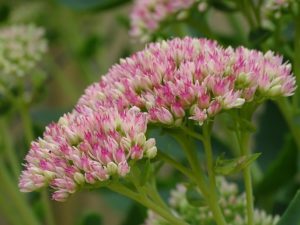
Sedum - Lavender. This drought tolerant evergreen shrubby plant also thrives in full sun. Beautifully scented flowers appear through summer.
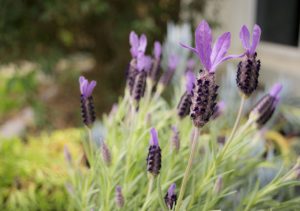
Lavender - Euphorbia. Their bright, citrus coloured bracts provide colour from springtime through summer. Easy to grow. Always wear gloves when handling these plants, the sap is a skin or eye irritant.

Euphorbia - Teasels. Make wonderful architectural features in gardens. Goldfinches and other garden birds feed off the seed heads, making them a favourite for wildlife gardens.

Teasels - Passion flowers. Beautiful climbing vines with lovely showy flowers. Best suited to sunny, sheltered sites in the warmer regions of the UK.

Passion Flower
In Conclusion
Rain water gardens are relatively simple to construct, they will add a new interesting feature to your garden and also attract wildlife.
Once established they are very low maintenance.
In 2017 the RHS produced a report that outlines the challenges gardeners will face
Milder winters
Drought
Extreme weather
Pests
For further information read
Gardening in a Changing Climate
If you have enjoyed reading this post and have found it useful, then please share with your friends. Also, feel free to share your views or ask questions in the comments box below.
Thank you
Louise

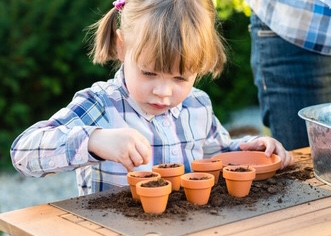



It’s so good to hear you speak of climate change today, I feel it is each and everyone of us job and responsibility to tackle the problem of climate change and one of the best ways, is through the planting and affore mentioned method. Have you heard of hydroponics before? Try that out too in your garden and you’ll understand how it helps tackle climate change problem.
Hello Salem,
I am very interested in hydroponics, it is a good way of planting and growing.
Thank you for your comments
You offer some great ideas for combating climate change while gardening. My mom has a huge backyard where she has some plants. I’ll show her this website so she can get some ideas on creating an environmentally friendly garden. She lives in the Caribbean and they have the wet and dry seasons so the rain garden and the dry garden concepts should be perfect for her.
Hello Dawn,Thank you for your comments and for sharing with your Mom,
I’m happy to know others are doing what 5ey can in their gardens to combat climate change.
Louise
Although way more physical effort is required a friend I had in the Lakenheath area many years ago used a reel type push mower to keep his lawn well manicured. The total lack of combustible fuel or electrical charge/energy is an attractive way to combat the serious problems of having so many resource using motors and engines doing the same work. The lawn was always pristine and also the exercise involved is of good benefit to the human body. I plan to soon use a reel push mower for my lawn in the USA. We should all go back to the harder and more healthy ways perhaps? Your article is well written and i enjoyed reading it.
Thanks
Rick.
Hi Rick,
I agree with you in some respects, yes the older tools were more environmentally friendly, sadly lifestyles are such now that everyone is too busy, have too many things going on and we want machinery that works quickly.
I would use manual tools for gardening if I only had my own garden to look after, however as a professional gardener I wouldn’t get much work done with all manual tools. I still use some tho or cordless where possible.
Happy Gardening
Louise
This is a very important topic that I think a lot of people take for granted or overlook as if it will someday just go away. Well they got that part right….it will ALL go away us included if we don’t all start doing our part.
I have never heard of a rain garden until today, what a great idea and some beautiful plants to choose from I’ve always loved the the “Iris” or what we call “ditch lillies” around here.
I was wondering if you had information on how to build a rain garden as well as how you can build a compost yourself?
Hello Amanda, thank you for taking time to comment.
I love Iris too they are lovely.
How to make a rain garden?
Compost can be made from all manner of garden and kitchen waste, all your garden plant rubbish, including twigs and small branches if they are shredded, raw food waste, except meat, egg shells, wood ash, old used compost and leaves. Throw it all in a bin, either you can buy plastic or wooden bins or make your own from old wood or pallets. It takes a good 8 months to a year to make good compost with a mix of wet and dry organic waste.
Turn it over every few months, a couple of bins is best as you can swap into another bin in order to give it a good mix up.
Hope this helps, I will be writing a “how to make compost blog now :))
Climate change is feared all around but there are sure ways to combat these changes. You have painstakingly took time to elaborate on these steps which I believe is ideal. It’s a tradition in my area to collect rain water which we usually use to water our lawn during drought. This way, we conserve alot of underground water.
HelloSammy,
Thank you,
Yes we need to do what we can to preserve water.
Hey! Thanks for sharing this nice article, I really appreciate you taking time and breaking it all down for us this is great.
I have sometimes wondered and done online research on how to combat climate change and I found this article informative and educative. You have really imparted me.
Again, thanks for building this website and investing your time. It’s a great site.
Hi,
Thank you for comments,I am pleased that you enjoyed the article, hopefully you will be able to do some of the things I mentioned.
Louise
This sounds so exciting and adventurous. I feel tickled by the theme. What an amazingly talented writer you are!
I’ve really enjoyed reading this article as you’ve provided us with lots of valuable information. I am just getting to know about combating climatic change in my garden. This is an eye opener for me because i must attest to the fact that i learnt alot from your wonderful write up. I will make sure I try it out and share with friends and family
Hello Tracy,Thank you for your comments, I am pleased to know my review was useful for you.
Thanks for sharing.
Louise